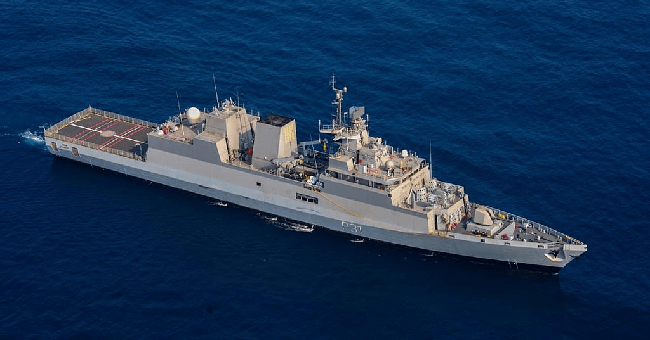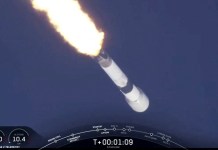As China continues to increase its influence in the Indian Ocean, India is also adding more muscle power to its anti-submarine warfare with the last of four indigenously-built Anti-Submarine Warfare (ASW) stealth corvette – INS Kavaratti.
How Has China Reacted To QUAD As India, US, Japan, Australia Inch Towards Asian NATO?
Indian Army Chief MM Narvane commissioned indigenously-built Kavaratti into the Indian Navy as a combat-ready platform at Naval Dockyard, Visakhapatnam on Thursday.
INS Kavaratti, last of the 4 indigenously built Anti-Submarine Warfare stealth corvettes, is all set to join Indian Navy.
Designed by Indian Navy's Directorate of Naval Design, the ship portrays our growing capability in becoming self-reliant through indigenization: Indian Navy pic.twitter.com/jHFcuGIkwT
— ANI (@ANI) October 22, 2020
Built by the Garden Reach Shipbuilders and Engineers, Kolkata, Kavaratti is a leap forward in Indian Navy’s attempt at indigenisation as it draws 90% of the content from India.
Named after the capital of the Union Territory of Lakshadweep, Kavaratti is the successor to Arnala-class corvette which participated in Operation Trident and was decommissioned in 1986.
#WATCH Andhra Pradesh: Anti-Submarine Warfare Corvette “INS Kavaratti” commissioned into Indian Navy by Indian Army Chief General Manoj Mukund Naravane at Naval Dockyard, Visakhapatnam. pic.twitter.com/1B9jJdD0K4
— ANI (@ANI) October 22, 2020
The ship, built under Project 28 (Kamorta class) at the cost $263 million, has completed sea trials of all the systems fitted onboard and is capable of fighting under nuclear, biological and chemical environments.
Talking to EurAsian Times, Commodore Anil Jai Singh, the Vice President of the Indian Maritime Foundation, says ASW is very important in Indo-Pacific context as India needs to counter the presence of a lot of Chinese submarines, which is increasingly coming to the Indian Ocean.
Singh says that in the present environment in the region, battle space transparency is there with good means of surveillance through satellites, LRMP aircraft, UAVs as the ships on the surface of the sea can be monitored and tracked, but in this submarine offer element of stealth and surprise, the most portable naval weapon.
“So if an enemy has good submarine capability, in that case, we need the great anti-submarine capability,” he adds while talking about the importance of deploying INS Kavaratti.
Indigenously built Anti-Submarine Warfare (ASW) Corvette ‘Kavaratti’ to be Commissioned at #Visakhapatnam today by General MM Naravane #COAS. @theargus_in pic.twitter.com/jABE6kDvTI
— Argus News (@theargus_in) October 22, 2020
Among some important features of Kavaratti is that it comes with improved stealth features, lower top weight and maintenance costs due to a superstructure of carbon fibre composite material that has been integrated with its main hull.
The ship, which is 109 metres long and 12.8 metres broad and is highly maneuverable with a top speed of 25 knots, will be armed with a range of indigenously developed cutting-edge weapons and sensors, including “a medium-range gun, torpedo tube launchers, rocket launchers and a close-in weapon system”.
The ship is part of Kamorta-class corvettes or Project 28, a class of anti-submarine warfare corvettes currently in service with the Indian Navy, which was approved in 2008. The other three ASW stealth covettes were INS Kadmatt, INS Kiltan and INS Kavaratti commissioned in 2014, 2016, 2017. The project had aimed to achieve localisation and development of warship construction industry in India.
“These ships are designed with very good noise-damping techniques, the kind of design that has been done and kind of material that has been used are meant so that self-noise of the ship is not picked-up by the submarine at long ranges, that is why composite has been used,” Singh says.

The ASW stealth corvette will be carrying torpedoes, sonars, and it also has the capability to carry anti-submarine warfare helicopter, which provides forward presence.
“They will be used to escort aircraft carrier, as part battlegroup. It’s a versatile, modern platform, which will be effective and adds a lot of muscle to Indian Navy’s ASW capability which is becoming increasingly important so it’s a timely addition to the fleet,” Singh says.
Presently, when Indian Navy has been carrying out exercises in the south-eastern Indian ocean, and if Chinese submarine comes from Malacca strait, Sula Strait, or Lombok strait, it is effective is to have ASW right there so they cannot penetrate further.
The whole new class of corvettes under Project 28 includes networks such as the Total Atmospheric Control System (TACS), Integrated Platform Management System (IPMS), Integrated Bridge System (IBS), Battle Damage Control System (BDCS) and Personnel Locator System (PLS).




